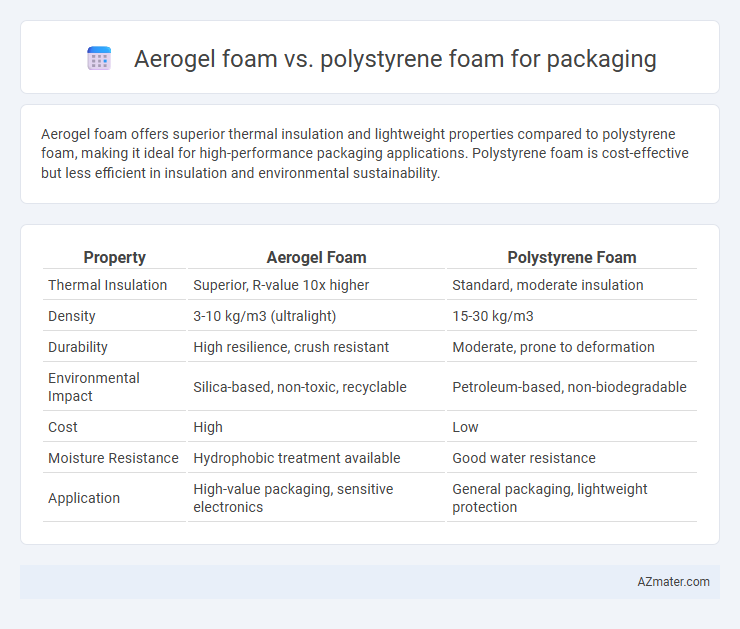Aerogel foam offers superior thermal insulation and lightweight properties compared to polystyrene foam, making it ideal for high-performance packaging applications. Polystyrene foam is cost-effective but less efficient in insulation and environmental sustainability.
Table of Comparison
| Property | Aerogel Foam | Polystyrene Foam |
|---|---|---|
| Thermal Insulation | Superior, R-value 10x higher | Standard, moderate insulation |
| Density | 3-10 kg/m3 (ultralight) | 15-30 kg/m3 |
| Durability | High resilience, crush resistant | Moderate, prone to deformation |
| Environmental Impact | Silica-based, non-toxic, recyclable | Petroleum-based, non-biodegradable |
| Cost | High | Low |
| Moisture Resistance | Hydrophobic treatment available | Good water resistance |
| Application | High-value packaging, sensitive electronics | General packaging, lightweight protection |
Introduction to Packaging Foams
Aerogel foam offers superior thermal insulation and lightweight properties compared to traditional polystyrene foam, making it ideal for packaging sensitive electronics and perishables. Polystyrene foam, widely used for its low cost and shock absorption capabilities, remains popular in everyday packaging applications. Understanding the distinct material properties and performance metrics of aerogel and polystyrene foams is essential for selecting the optimal packaging solution.
What is Aerogel Foam?
Aerogel foam is an ultra-lightweight, porous material composed primarily of silica, known for its exceptional thermal insulation properties and high compressive strength, making it ideal for advanced packaging applications. Unlike polystyrene foam, aerogel foam offers superior resistance to moisture and temperature fluctuations, enhancing protection for sensitive or high-value products during shipping and storage. Its unique nanostructure reduces heat transfer significantly, providing efficient insulation while maintaining minimal bulk.
What is Polystyrene Foam?
Polystyrene foam is a lightweight, rigid material commonly used in packaging due to its excellent cushioning properties and cost-effectiveness. It consists of expanded beads of polystyrene resin, creating a cellular structure that provides thermal insulation and shock absorption. Compared to aerogel foam, polystyrene foam offers lower thermal resistance but remains widely favored for protecting fragile items during shipping and reducing packaging weight.
Thermal Insulation Performance
Aerogel foam offers superior thermal insulation performance compared to polystyrene foam, boasting thermal conductivity values as low as 0.013 W/m*K, which significantly reduces heat transfer in packaging applications. Polystyrene foam typically exhibits higher thermal conductivity around 0.03 W/m*K, resulting in less effective temperature control. This makes aerogel foam a preferred choice for packaging sensitive products requiring optimal thermal protection over extended periods.
Mechanical Strength and Durability
Aerogel foam offers superior mechanical strength and durability compared to polystyrene foam, making it highly effective for packaging fragile and high-value items. Its nanostructured composition allows for enhanced shock absorption and resistance to deformation under pressure, outperforming the brittle nature of polystyrene foam. Aerogel's long-term stability and resistance to moisture degradation ensure sustained protective performance in demanding storage and transit conditions.
Environmental Impact and Sustainability
Aerogel foam exhibits superior environmental benefits compared to polystyrene foam due to its biodegradability and lower carbon footprint during production. Polystyrene foam, derived from non-renewable petroleum resources, contributes significantly to plastic pollution and is challenging to recycle, leading to long-term environmental persistence. Sustainable packaging solutions increasingly favor aerogel foam for its energy-efficient manufacturing process and reduced ecological impact throughout the product lifecycle.
Weight and Handling Efficiency
Aerogel foam offers significantly lower density compared to polystyrene foam, resulting in lighter packaging that reduces shipping costs and improves handling efficiency. Its superior compressive strength allows for thinner layers without compromising protection, enhancing space utilization and ease of maneuverability during packing processes. Polystyrene foam, while lightweight, tends to be bulkier and less durable, increasing the volume of materials handled and potentially slowing down packing and unpacking workflows.
Cost Comparison and Availability
Aerogel foam typically costs significantly more than polystyrene foam due to its advanced insulating properties and complex manufacturing processes, making it less accessible for large-scale packaging applications. Polystyrene foam offers widespread availability and low production costs, driving its prevalence in disposable and bulk packaging solutions. While aerogel foam provides superior thermal insulation, polystyrene's cost-effectiveness and ease of sourcing often make it the preferred choice for budget-sensitive packaging needs.
Industry Applications and Use Cases
Aerogel foam offers superior thermal insulation and lightweight properties, making it ideal for high-value electronics packaging and aerospace applications where temperature control and weight reduction are critical. Polystyrene foam is widely used in consumer goods and food packaging due to its cost-effectiveness and shock absorption capabilities, effectively protecting fragile items during shipping. Industries like pharmaceuticals benefit from aerogel foam for temperature-sensitive drug transport, while polystyrene foam remains dominant in bulk packaging and disposable containers.
Future Trends in Packaging Materials
Aerogel foam offers superior thermal insulation, lightweight properties, and environmental sustainability compared to traditional polystyrene foam, driving its adoption in next-generation packaging solutions. Innovations in aerogel composites and biodegradable formulations are expected to reduce carbon footprints and enhance product protection during transport. Market trends indicate growing demand for eco-friendly, high-performance packaging materials, with aerogel foam positioned to revolutionize sectors such as electronics, pharmaceuticals, and perishables.

Infographic: Aerogel foam vs Polystyrene foam for Packaging
 azmater.com
azmater.com